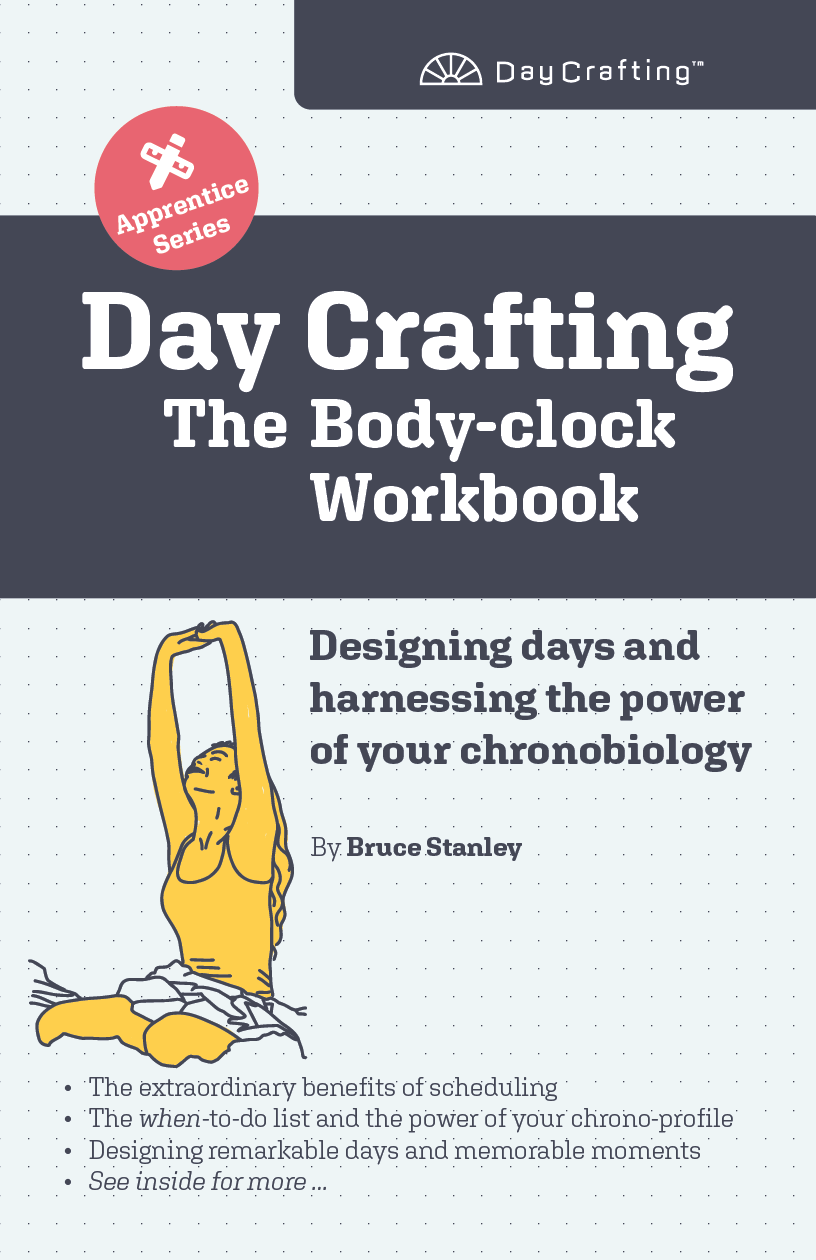Reset your days to your internal clock
- Bruce Stanley

- Apr 21, 2021
- 5 min read
Updated: Jul 23
Imagine a clock that told you personally when it was your best time during the day to do certain tasks, such as the optimum time to do analytical thinking or to have a difficult conversation. The best time to eat carbohydrates or to drive, or to have sex. This clock could be fairly specific and handle conditions, for example, it could tell you when to exercise to perform at your best, or to lose weight or to raise your mood, or to build strength or avoid injury (each of these conditions would give a different time). It could give you a surprisingly long list of optimum timings – like the best time to make a sale or take medicine, to learn something, to drink alcohol, visit the dentist, solve creative problems and get out into the sunshine, to go first – or not, to work on through or to take a break. And unsurprisingly, when to get up and when to go to bed.

What would your days be like if you followed this personal clock of optimal timing rather than the clock on the wall or the schedule in your diary (which may be shaped by no more wisdom than simply fitting meetings into free gaps)? For starters, you would be much happier, healthier, and have more energy to be more productive if that's how you chose to use that energy. We could call the clock on the wall social time, as it is a fairly recent invention of society. The wonderful, personal clock of optimal timing – we might call it your chronorhythm, or your circadian or biological rhythm, if you prefer. This chronorhythm clock, your clock, is unique to you, and it would be very rare for it to follow the regimented 24 hours of social time – hence the term circadian (around a day). In fact, the average runs to about 24 hours and 15 minutes. (Our chronorhythm mainly uses the light from a third clock, sun-time, to adjust to a 24-hour period through a process called entrainment.) Of the three clocks — sun, social, and internal — we undervalue the last to our detriment. Increasingly, people are reclaiming the benefits of shifting from GMT (Greenwich Mean Time) to CMT (Circadian Me Time).
The Impact of Chronorhythm on Daily Life and Social Dynamics
Your internal clock, your chronorhythm, is a hard-wired biological phenomenon and can be dramatically different from that of another person or from the population average. For example, if we measure the midpoint of your sleep, and you are an extreme early riser, that midpoint could be 12 hours earlier than the sleep midpoint of an extreme late riser. Why do humans across a population show such divergence? One hypothesis is that it protected the tribe during the night – just as teenagers are finally nodding off in the early hours, the older folk are leaping sprightly from their beds. For extreme chronotypes, our artificially regimented 9 to 5 industrial society is an especially challenging place to be. It can also cause difficulties within a household if chronotypes differ dramatically – think of those teenagers again.
Most of the population are not at the extremes. About 65% of us wake up around 7am and go to bed around 11pm, and society is structured to suit this group. Early risers tend to adapt to this routine by fitting in some useful, undisturbed productive hours before most people start work later on, but they often find social events in the evening challenging. These two groups also exhibit similar energy and cognitive rhythms throughout their days, showing a pattern of rising, dipping, and rebounding in energy during waking hours. The hardest group to accommodate is the late risers, whose optimal sleep and energy rhythms differ the most and follow a different order.
Research indicates that different chronotypes display distinct personality traits, such as larks being introverted leaders, but it's easy to interpret this deterministically. There appears to be a moral claim that chronotype is a matter of productivity – the early riser is highly praised worldwide: in the UK, the 'early bird catches the worm'; in Russia, it is the 'early riser who gets the mushrooms' (while others gather nettles). Other idioms include: in Germany, 'the morning has gold in its mouth'; in Sweden, 'the first to the mill gets to grind first'; and in Italy, 'he who sleeps catches no fish.' Despite all the advice about hacking your day by waking earlier, you cannot change your chronotype – all you can do is mitigate the side-effects of shifting your internal clock.
Understanding the Evolution of Your Chronotype Over Time
But your chronorhythm might change over time. Although a fact of our biology, the chronotype shifts throughout our lifetime. From a preference for staying up late and waking late as older teenagers, we tend to become earlier chronotypes as we grow older, and men and women experience these changes at different rates. If you recall being a late riser as a teenager, it is perfectly normal not to be one later in life. By the way, babies (as with some elderly people) may not strictly follow a circadian rhythm but instead operate on an ultradian rhythm, which is shorter than a day.
If you're unsure which chronotype you belong to, there's a fairly reliable way to determine it by dividing the population into four common types. Consider what your natural sleeping pattern would be during a holiday or rest day when you don't need to get up at a specific time. Then, work out your sleep midpoint. If it is before 3.30am, you're an early chronotype. If it falls between 3.30am and 6.00am, you're an average chronotype. And if it is later than 6.00am, you're a late chronotype. A lark, a finch or an owl. I mentioned that there are four common types – so if you don't fit into any pattern and find your sleep unpredictable, you might be a 'problem' sleeper, but you probably suspected that already.
Optimizing Productivity Through Chronorhythm Awareness
Working in harmony with our individual chronorhythm has become the foundation of my work with Day Crafting Apprentices. Once we're aware of our chronotype and our own optimal timings for various tasks, we can turn our to-do list into a when-to-do list. Days designed this way accomplish more with less effort, and the quality of our work improves. With experience, we can also mitigate the times when we are forced to go against our chronotype. We can even identify opportunities to optimise timings involving others and their chronotypes to our advantage. For example, if you're able to influence when something important involving others should happen, like a meeting to discuss a contract or make a creative decision, you can schedule the meeting to suit the type of cognitive work required.
There is a time of day that is better for logical but not especially creative thinking, and vice versa – as well as a time when, depending on the nature of the work, taking breaks is essential for our performance. As previously mentioned, a long list of time-optimised schedules exists for each of us, from aerobics to zzzz. Our circadian rhythm encompasses more than just sleep timing – although that is the most crucial aspect of your overall chrono-performance to optimise. Many of our hormones, and consequently the behaviour they influence or hinder, are triggered by the same internal clock. General advice would be to work with these natural rhythms, obtaining early exposure to natural light, delaying caffeine intake until the morning cortisol surge has done its job of waking us naturally, and scheduling the day's tasks to align with cognitive peaks and energy levels.
Perhaps we’ve been searching in the wrong place for the good life. It’s not the reward, far off in the future at the end of a process borrowed from sport or business coaching, but is present in the steady daily rhythm of the craftsperson, free from the industrialist's nine-to-five. Annie Dillard wrote, ‘How we spend our days is, of course, how we spend our lives.’ To craft a good life, we need to focus our attention on the working surface—the rhythms that balance our energy and rest throughout the day.










Comments